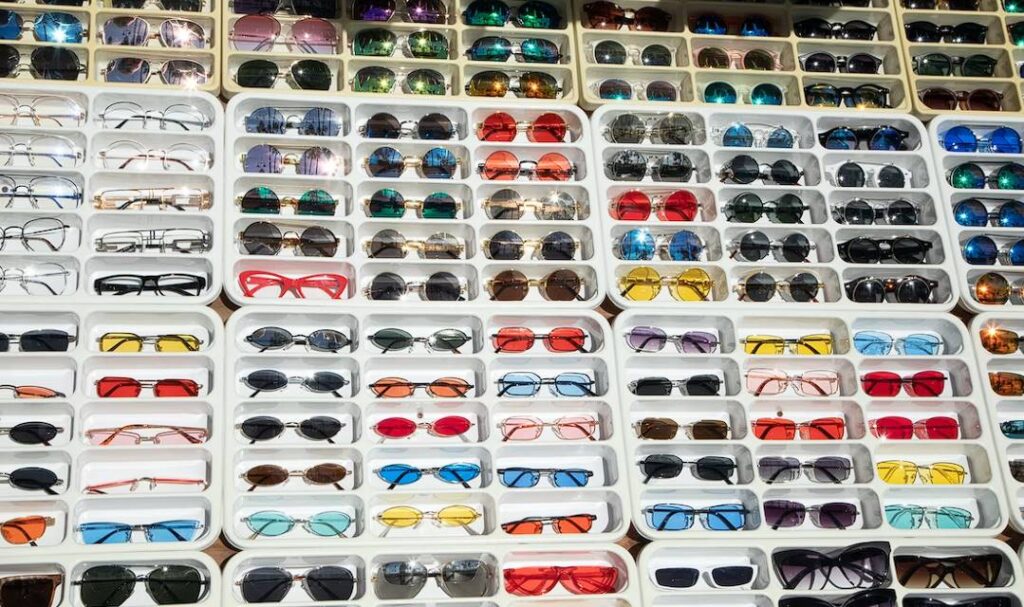Wearing the appropriate sunglasses while driving is not only a fashion statement, but also an issue of safety and comfort. Sun glare reduces one's ability to see clearly while driving and increases the likelihood of both accidents and fatigued eyes. Factors such as lens tint, polarised lenses, UV protection, and frame design should all be taken into account when selecting the best sunglasses for driving.
This article offers helpful advice for picking out a pair of sunglasses that are made with safe driving in mind. If you know what to look for, you can improve your vision, lessen glare, and have a more pleasurable and secure trip. Let's go on an adventure to find the best pair of sunglasses for driving conditions.
What Are Driving Sunglasses?
Sunglasses designed specifically for use while driving are called driving sunglasses. They're great for protecting your eyes from the sun at the most glaring times of day, like when you're driving or commuting at dawn or dusk.
The sun will be more visible as it rises at these times (which coincide with rush hour). This makes it difficult to read the road, which is a major safety risk for you and other drivers.
This is crucial. The right pair of sunglasses can do more than just improve your comfort on the road; they can also save your life by reducing distractions while you drive.
There is no need to go out of your way to find a specific pair of sunglasses for use while driving, but there are a few "must-have" qualities to keep in mind. Possessing these qualities will enhance your driving experience in general.
Why Should We Wear Sunglasses When Driving?
The necessity of sunglasses while driving must be stressed first.
Sunglasses shield your eyes from harmful ultraviolet light and, with any luck, enhance your field of vision. When visibility is low, this can help reduce the risk of an accident. Wearing sunglasses can help reduce the amount of light entering your eyes, making it so you don't have to squint as much. When behind the wheel, this is incredibly helpful because squinting reduces your field of vision and gives you a headache.
Are polarised Glasses Better For Driving?
Can I safely drive with polarised sunglasses on my face? Experts say that polarised lenses are not always necessary for driving sunglasses, despite the fact that they can help with glare reduction.
Polarised driving sunglasses may be less effective depending on the direction of the sun. Because of their ability to reduce glare, they shine brightest on sunny days. Anti-reflective coatings on lenses are also useful. Because the polarised lens attracts oils and scratches on your helmet's visor, it is not safe for motorcyclists to wear them.
What Makes A Great Pair Of Driving Sunglasses?
The most effective pair of driving sunglasses will block or significantly diminish glare. The glare from the road and other flat surfaces, including the driver's vehicle's hood and the windscreens and other reflective surfaces of other vehicles, can be greatly reduced with polarised sunglasses.
Sunglasses designed specifically for driving benefit from a large, wraparound frame that does not obstruct the driver's peripheral vision. When driving with the sun in your rearview mirror, an anti-reflective coating on the inside of the lenses will prevent distracting glare.
Finally, driving glasses with a brown, copper, or amber tint will improve contrast on cloudy days as well as sunny ones.
Driving safely requires a combination of good visibility and clear, comfortable vision. The last thing you need is for the sun to blind you as you make split-second decisions at high speeds. A common first line of defence is a good pair of sunglasses for driving.
It helps if they're attractive, too.
Frame Technology
Fit
When looking for new sunglasses, the first thing you should do is try a few pairs on to ensure a good fit. It's important that your sunglasses don't press against your temples because some of us spend a lot of time in cars. Migraines and other forms of head pain may result. Finding frames with either straight or slightly hooked temples is a good starting point.
Grip
Rubberised nose pads and temple tips are another useful addition to driving sunglasses. For sunglasses to be worn while driving, this is not a necessary feature. Rubberized temple tips and nose pads are a must if you plan on using your sunglasses for anything other than driving. The hydrophilic material used by most manufacturers becomes stickier as perspiration accumulates.
Coverage
Sunglasses made specifically for driving should have frames that are both wider and taller than the average pair. Keep an eye out for a wraparound style, too. Side sunlight can enter a car and obscure the driver's view. A large lens or wraparound frame will provide protection from every direction. A 6-base or flat frame is a good choice if you want to look casual without sacrificing comfort.
Material
The frame material is the final factor to think about when looking for driving sunglasses. There is no "best" frame material for sunglasses worn while driving; rather, the choice comes down to individual taste. Acetate frames are the most comfortable option. Acetate is well-known for its distinctive feel, beautiful patterns, and vivid colour retention.
Nylon is an alternative choice for the frame's material. Because of its light weight and pliability, nylon is an excellent material for sunglasses. They are great all-around sunglasses because nylon can maintain its form in harsh environments.
Metal should be your last option for a frame material. Metal frames don't usually come in wraparound styles, but they're usually quite light and have thin temples to ensure a good fit.
Lens Technology
polarised Lenses
Any decent pair of driving sunglasses should have polarised lenses. Headlights, stop signs, and any wet areas on the road all reflect the sun as you drive. The brightness of the sun can make it difficult to see the road ahead. While driving, polarised lenses allow your eyes to rest and feel less strain.
Keep in mind that a polarised lens may prevent you from seeing the digital dashboard displays in some newer vehicles. If you invest in polarised lenses, try them out in your vehicle first before hitting the road.
Material
Glass and polycarbonate are the two most common materials for eyeglass lenses. Lenses made of glass are the most durable and scratch-proof option. Glass lenses have the drawbacks of being heavier and less resistant to impact. This is also why they are so hard to obtain via prescription.
Polycarbonate lenses are advantageous because they are both lightweight and resistant to impact. Polycarbonate lenses have the disadvantage of being less durable and less clear than glass ones.
Transitions Lenses
There's a good reason why transition (or photochromic) lenses are such a hot commodity in the optical market. Depending on the amount of light entering the lens, these glasses will change from clear to dark. Unfortunately, Transitions lenses aren't as good for driving as other brands. This is due to the fact that the necessary ultraviolet light cannot reach the lens through car windscreens, rendering it permanently clear.
If you're set on getting photochromic lenses, the Serengeti Drivers lenses are your best bet. The lenses in a Serengeti respond to both visible and ultraviolet light, so they darken when shielded from sunlight.
Gradient Lenses
The top of gradient lenses are dark and gradually get lighter as you move down the lens. These glasses may be better known for their fashion value, but they are a practical choice for the road. The driver's eyes naturally move to the shaded area of the lens when they are concentrated on the road. When looking down at the dashboard, the lens becomes clearer, making the screen easier to read.
What To Look For In A Pair Of Driving Sunglasses
When shopping for a new pair of sunglasses for use while driving, keep the following in mind:
100% Uv Protection
Even though a car windscreen blocks most UV light, it is still important to wear protective gear whenever you are out in the sun. Try to find glasses with complete protection from UVA and UVB rays.
polarised Lenses
A unique coating that lessens annoying glare during daylight hours of driving.
The Right Lens Coverage
Wider, taller lenses with a slight curve provide better protection for a wider field of view because the driver cannot always predict where the sun will be.
Durability
The best sunglasses for driving are sturdy enough to withstand being thrown around in the car, worn for long periods of time, and removed repeatedly.
Comfort
Comfort is just as important as functionality when it comes to driving sunglasses.
Style That Fits Your Face Shape
Get a head start on your sunglass shopping if you know which frames work best with each face shape.
Best Sunglasses Lens colour For Driving
A number of factors determine what kinds of sunglasses are acceptable for use behind the wheel. The way in which various lenses let light through can vary greatly. When shopping for the best sunglasses for driving that fulfil vision requirements for driving, you can pick from four or five category labels of glare reduction. Thus, it is also significant to consider the colour of your sunglasses. Lenses in shades of grey, amber, or copper are best for driving because they keep colours distinct. Light green, blue, red, and pink distort vital colours needed to see traffic lights.
Try to find a pair of glasses that sits comfortably and not too tightly on your face. Choose lenses that have UV protection, a grey or amber tint, and anti-glare coating. Pick out a frame that isn't too bulky, as doing so can obscure your side vision, which is crucial while behind the wheel.
Consider getting a pair of transition lenses, which darken in response to UV light, if you spend a lot of time behind the wheel. Because Transition lenses are activated even behind the windscreen of a car, they darken in the sun and fade back to clear as you drive; this eliminates the need to switch from your regular eyeglasses to sunglasses. Therefore, transition lenses are highly recommended for long trips during which nighttime driving is a distinct possibility.
Conclusion
Lens tint, polarised lenses, UV protection, and frame design are all important considerations when shopping for driving sunglasses. These shades shield the eyes from the sun during peak sunlight hours, such as mornings and afternoons during rush hour. Wearing sunglasses while driving can help with glare, visibility, and keeping your focus on the road.
While polarised glasses may not always be required, they can reduce glare while driving. With their anti-reflective lens coatings, they really come into their own when the sun is out. The best sunglasses for driving are those that completely or nearly completely eliminate glare and have a broad, wraparound frame that does not restrict the wearer's field of view. Internal anti-reflective coatings on the lenses help cut down on annoying reflections.
For the best visibility and comfort when driving, use sunglasses with a big lens or wraparound frame and a 6-base or flat frame. Acetate, nylon, and metal can all work well as frame materials. Polarised lenses are a must for driving because unpolarised lenses cause glare and impair visibility. The two most prevalent types of lens material for eyeglasses are glass and polycarbonate. Polycarbonate lenses are lightweight and impact-resistant, while glass lenses are the most scratch-resistant and long-lasting option. Transition lenses, also known as photochromic lenses, are increasingly common because of their unique ability to alter their transparency in response to the amount of light striking the lens.
For both your safety and comfort on the road, the correct pair of sunglasses is a must. Selecting a good pair of sunglasses can improve visibility and lessen eye strain when driving. Practical for driving are gradient lenses, which lighten gradually as the wearer advances down the lens. They block out UV rays in their entirety, have polarised lenses, and have the ideal lens coverage to maximise peripheral vision. Both durability and comfort are essential.
Each facial structure has a corresponding recommended hairstyle. Lens colours like grey, amber, or copper help maintain colour contrast, making them ideal for driving. Select a pair of sunglasses that fit well and aren't too bulky, preferably with anti-glare coating, grey or amber tint, and UV protection. For long excursions that involve nighttime driving, transition lenses, which darken in response to UV light, are a must-have.
Content Summary
- Choosing the right sunglasses for driving is important for safety and comfort.
- Sun glare can impair vision and increase the risk of accidents.
- Factors like lens tint, polarised lenses, UV protection, and frame design should be considered.
- Driving sunglasses are designed to protect the eyes during the most glaring times of day.
- They can improve visibility and reduce distractions while driving.
- Sunglasses shield the eyes from harmful UV light and enhance vision.
- Squinting while driving reduces the field of vision and can cause headaches.
- Polarised lenses can help reduce glare but may not be necessary for all driving conditions.
- Glare from the road and reflective surfaces can be reduced with polarised sunglasses.
- A large, wraparound frame is beneficial for driving sunglasses.
- Anti-reflective coating on the lenses prevents distracting glare.
- Brown, copper, or amber-tinted lenses improve contrast in different weather conditions.
- Good visibility and clear vision are crucial for safe driving.
- Sunglasses should have a comfortable fit and not press against the temples.
- Rubberised nose pads and temple tips provide extra grip.
- Wide and tall frames with a wraparound style offer better protection.
- Acetate frames are comfortable, while nylon frames are lightweight and durable.
- Glass lenses are durable and scratch-proof, while polycarbonate lenses are lightweight and impact-resistant.
- Transition lenses change from clear to dark based on the amount of light.
- Gradient lenses offer a practical choice for driving, with a shaded area for focused vision.
- Look for sunglasses with 100% UV protection.
- Polarised lenses reduce glare during daylight hours.
- Wider and taller lenses with a slight curve provide better protection and visibility.
- Durable sunglasses can withstand daily use and wear.
- Comfort is essential for long hours of driving.
- Consider the face shape when choosing a style of sunglasses.
- Grey, amber, or copper-tinted lenses are best for driving.
- Avoid lenses that distort important colours, like traffic lights.
- Look for a comfortable fit that allows proper side vision.
- UV protection, grey or amber tint, and anti-glare coating are important features to consider.
- Transition lenses darken in response to UV light and are ideal for long trips and nighttime driving.
- Sunglasses for driving should be selected based on their performance and functionality.
- Consider the time of day and weather conditions when choosing lens colour.
- Properly fitted sunglasses can enhance comfort and safety while driving.
- The right sunglasses can reduce the risk of accidents and eye fatigue.
- polarised lenses reduce glare and provide clearer vision.
- Frames with a wraparound design offer better protection from side sunlight.
- Acetate and nylon frames are comfortable and durable choices.
- Glass lenses are durable and scratch-proof, while polycarbonate lenses are lightweight and impact-resistant.
- Transition lenses are a convenient option for changing light conditions.
- Gradient lenses provide shaded areas for focused vision while driving.
- Look for sunglasses with 100% UV protection for optimal eye safety.
- The right lens coverage ensures a wider field of view and better sun protection.
- Durability is important for long-term use and resistance to damage.
- Comfortable sunglasses are essential for a pleasant driving experience.
- Choose sunglasses that complement your face shape for a stylish look.
- Lens colour is crucial, with grey, amber, or copper tints providing better colour contrast.
- Avoid lenses that distort important colours needed for driving.
- Proper fit and features like UV protection and anti-glare coating are important considerations.
- Transition lenses are recommended for long trips and variable light conditions.
Frequently Asked Questions
Sunglasses specifically designed for driving help reduce glare from the sun, enhance visibility, and increase overall safety on the road. They provide protection against harmful UV rays and ensure optimal visual clarity, allowing you to focus on the road ahead and avoid potential hazards caused by glare.
For driving sunglasses, it is recommended to choose lenses with a neutral or gray tint. These tints maintain true colour perception while reducing brightness and glare. Avoid lenses with overly dark or colourful tints, as they may distort your vision and hinder your ability to accurately judge distances and traffic signals.
polarised lenses are highly beneficial for driving sunglasses. They reduce glare by blocking horizontal light waves that cause reflections. This helps improve visibility, especially on wet surfaces or in bright sunlight. polarised lenses enhance contrast and provide a clearer view of the road, making them an excellent choice for driving.
UV protection is essential in driving sunglasses. Prolonged exposure to harmful UV rays can damage your eyes and increase the risk of cataracts and other eye conditions. Look for sunglasses that offer 100% UV protection or have a UV 400 rating. This ensures that your eyes are shielded from both UVA and UVB rays while driving.
Yes, frame design is an important consideration for driving sunglasses. Opt for a frame that provides ample coverage to shield your eyes from sunlight entering from the sides. Wraparound or larger frames with a close fit offer better protection and reduce peripheral glare. Additionally, lightweight and comfortable frames are ideal for extended periods behind the wheel.










